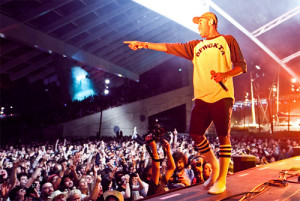The Odd Future Of Hip-Hop Marketing
RRows upon rows of enthusiastic fans dressed from head to toe in Supreme wait patiently on a freezing cold afternoon in central London for controversial hip-hop group Odd Future to arrive. Chants of “wolf gang” break out in the queue stretching several streets as members begin to make their way into the “OF Sweatshop“, a unique one day only pop up store, selling exclusive one off garments which amount to a majority share of the outfit’s income seeing as they, unusually, give all their music away free.
The never seen before marketing technique, or lack of as the case may be, is yet another example of the Los Angeles based collective’s adversity to conformity. The identity of the group is largely credited to the founder, Tyler, The Creator, described as a “sadistic yet compelling performer” by the New York Times. His antics both on and off-stage continue to define the rebellious, alternative leanings that have come to be associated with the young ensemble, including Earl Sweatshirt, Domo Genesis, Mike G, Frank Ocean, Left Brain, Syd, Jasper Dolphin, and Taco Bennett.

Image credit: Charlotte Zoller on Flickr
The success of the movement started and was cemented online, with more than 20 albums offered free through the group’s website, building a fan loyal fan base in return. OF made money independently since early on, selling homemade merchandise directly to fans, offering lots of limited edition garments and one-off products, all hand designed by founder Tyler, breaking down the barrier between artist, production and consumer. They later combined that approach with their highly successful tours, launching pop-up stores in every city before performing. They meet and greet at the shop, take photographs and sign autographs, giving their fans unparalleled access to the group, a hip-hop movement of which are usually notoriously hard to reach.
Tour merchandise has always been present and popular, but Odd Future redesigned the experience. As opposed to selling cheap generic t-shirts featuring printed logos on a table as you enter the venue, forcing the fan to pay over the odds of course, they turn it into a whole companion experience to the show. Marrying with the culture of “hype” associated with hip-hop, which role model to Tyler and avid OF supporter, Pharrell Williams played a part in creating, they offer merchandise that’s one-of-a-kind, which can’t be bought online, in stores or at other shows, reinventing the phrase “exclusive”.
There has been talk since the groups transition from rebel teenagers to independent entrepreneurs, as to whether the laid back lack of marketing technique is really a hidden part of a much larger plan by a puppet master record label figure to gain a hold on the potential market of youth non-conformity, though manager Christian Clancy reassures fans it’s just exactly that; talk:
“There’s no marketing, it’s exposing it at the right place at the right time. So when you have kids that are completely themselves, you don’t necessarily market because you just take who they are and expose it. Right? So it’s not like a push.” Christian Clancy.
The choice in management often depicts how the group is portrayed and pigeonholed in the music industry, though Clancy’s wealth of experience enables him to break that mould and create an entirely new pigeonhole for his acts. His first major project came as a bit part production job for Interscope records on Eminem‘s “The Marshall Mathers LP“, a legendary album by an artist in similar social standing to that of Odd Future, raunchy bordering on offensive. Clancy’s time spent with Eminem proved invaluable, teaching the production intern the power of the pulling consumers into a brand or product as opposed to forcibly pushing via advertising and marketing.
This technique doesn’t work with every act however, only working well with Eminem and OF on account of both groups’ ability to mimic the “don’t give a damn” rebellious nature of the young consumer. Of course, Odd Future’s hyper-activity on social networking sites is an asset Eminem wasn’t able to make use of at the time.
Their constant use of Twitter, Tumblr and Vine, to name a few, pulls fans in in a way not seen before. The ring leader in particular, Tyler, The Creator, is an addict of social networking, promoting shows as well as merchandise adding personal reviews and opinions different to that offered by the common PR run social media of other artists; pulling consumers in to view advertising as opposed to the other way around, while giving the fan that unrivaled access to the group.
It can’t be denied that Odd Future, whether intentional or not, have implemented the perfect pull from a marketing perspective. Through the obvious recluse of advertising and traditional “push” of consumers toward the brand, fans feel closer and more involved with the group and specific individuals within. Aided in chief by the decision to give away an extensive amount of material for free, OF have been the first to give as much emphasis to clothing and merchandise as the traditional focus of an act: the music. A technique, which appears to be working:
“…Made a quarter million off of socks, ****, cos it’s the G.O.L.F.W.A.N.G.” Tyler, The Creator, “Whoa”, feat. Earl Sweatshirt, “Doris”.


Comments